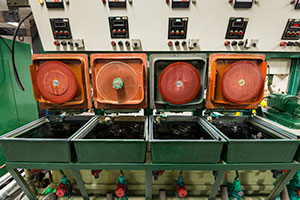Vinyl destination
Simply sign up to the Life & Arts myFT Digest -- delivered directly to your inbox.
In a small, dimly lit studio perched on the edge of London’s Westway flyover, Pete Hutchison is listening closely. Very closely. Not that there is any need to strain. Beethoven’s Symphony No 9 cascades like an avalanche from a rotund pair of speakers; explosive timpani pound the air of the soundproofed room into its fabric-lined walls.
Volume is unlikely to make much difference to Hutchison’s trained ear. He’s something of an aural specialist, producing hyper-authentic pressings of rare mid-20th-century classical vinyl records.
Releases by The Electric Recording Company, Hutchison’s production outfit, are valuable: a volume of Bach’s unaccompanied violin sonatas by Johanna Martzy sells for £300; it’s £2,500 for a seven-LP box set of Mozart à Paris with conductor Fernand Oubradous. The cost, he says, is a result of the time and effort that goes into the manufacture of the albums: this is more than reproduction, this is replication down to the last audiovisual detail. “If you think of an audiophile as an outpatient at a psychiatric ward then us, in here with this equipment, we’re sectioned,” he says.
The equipment is a retro hulk of pistachio machinery called a Lyrec, an all-valve vinyl cutting system built in Denmark in the early 1960s. It comes from an era before studios used transistors and long before digital – both revolutions in the music industry that offered greater convenience but, says Hutchison, at a huge cost to audio quality. “Analogue was better – is better – than digital, and that’s the truth and the truth doesn’t hide itself.”
Hutchison says the machine is the only working one of its kind in Europe, possibly the world. With it, he is able to produce re-pressings that preserve the original audio texture of the master tapes, which he says offers a richer sound.
“It seems to connect emotionally, more than some of the later equipment,” he suggests. “People have been overwhelmed by the sound but also by the effort we’ve gone to to make the records pleasing aesthetically and feel like a timeless artefact, rather than the usual corporate reissue.” The album sleeves are printed with antique Heidelberg letter presses.
Demand for ERC products is high. According to figures from the British Phonographic Industry trade association, year-on-year sales of vinyl in the UK were up by 101 per cent in 2013, increasing more than 270 per cent in the past five years.
After the onslaught of digital downloads, the desire for physical albums is about sound quality but is also a material celebration of music.

“The resurgence [in vinyl] is about this as much as anything else,” says Sean Bidder, creative director at The Vinyl Factory, an independent record label and the UK’s last major vinyl manufacturer. “It’s more collectable. It’s a craft that fits in with the analogue trend.”
The Vinyl Factory’s west London pressing plant makes between one and two million records a year – not a patch on the 20 million it churned out in the 1960s and 1970s, but numbers are increasing. “We’ve seen about a 10 per cent growth year on year for the last three years,” says Bidder. “Five to six years ago none of the big labels were pressing vinyl. Then last year Robbie Williams was given a first pressing of 20,000.”
The outfit makes bespoke limited editions (£20-£500) in collaboration with bands such as The Pet Shop Boys and The xx. “The quantity is smaller but the quality is higher,” says Bidder, who aims to produce “editions as collectable as art objects as they are as vinyl pressings”.
“There’s a growing appreciation amongst music lovers,” he adds.
Back catalogues also offer new value. “Five years ago it was a question that was rarely asked,” says Johnny Chandler, head of catalogue A&R at Universal Music, where he chooses the format for reissues. “Now we’re able to ask it almost every time of an artist’s catalogue: ‘What’s the vinyl offer, is there a vinyl offer?’’’
Chandler, who once owned a record shop, has been collecting vinyl since he was eight. He believes the format’s revival can be viewed as a manifestation of our materialist culture. “It doesn’t surprise me that people have returned to something like vinyl […] the idea that you want to physically get something for the money you spend, I kind of get that.”
Could we be emerging from a digital dark age then? “It’s not an either/or,” says Chandler.
Hutchison, at ERC, agrees: “There’s a place for digital. Digital is great for discovering new and old music but if you want the real deal you need the original pressing.
“Music is an art form. Art should not be about convenience. Why buy a poster when you can have an original print?”
Seb Morton-Clark is a video producer-reporter at the FT. To comment on this article please post below, or email magazineletters@ft.com
Comments